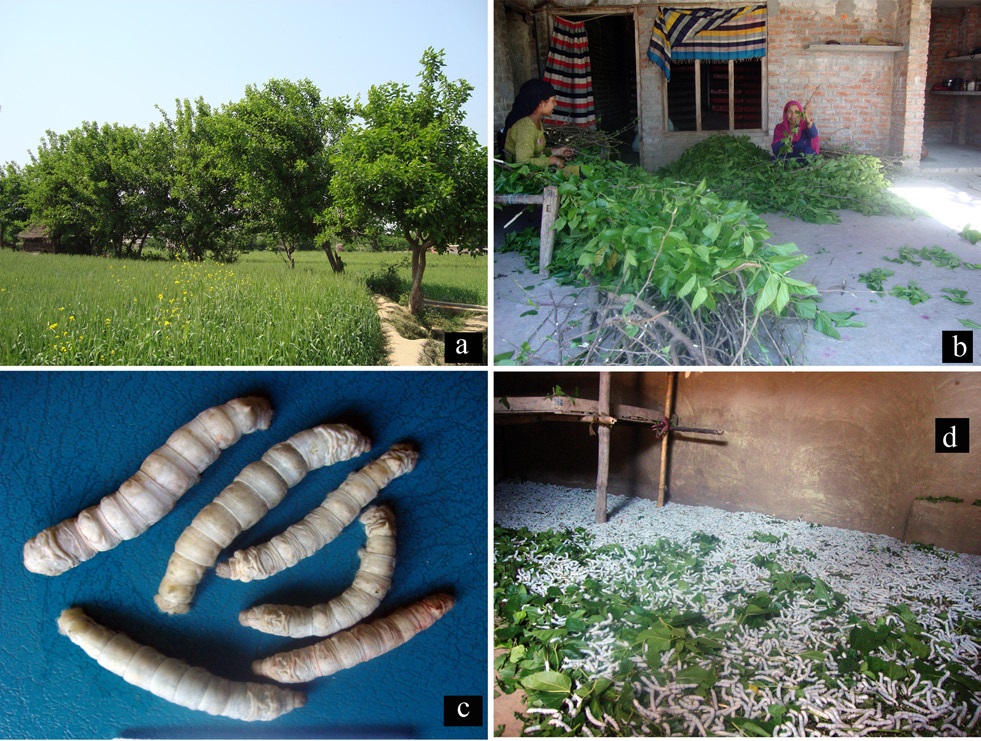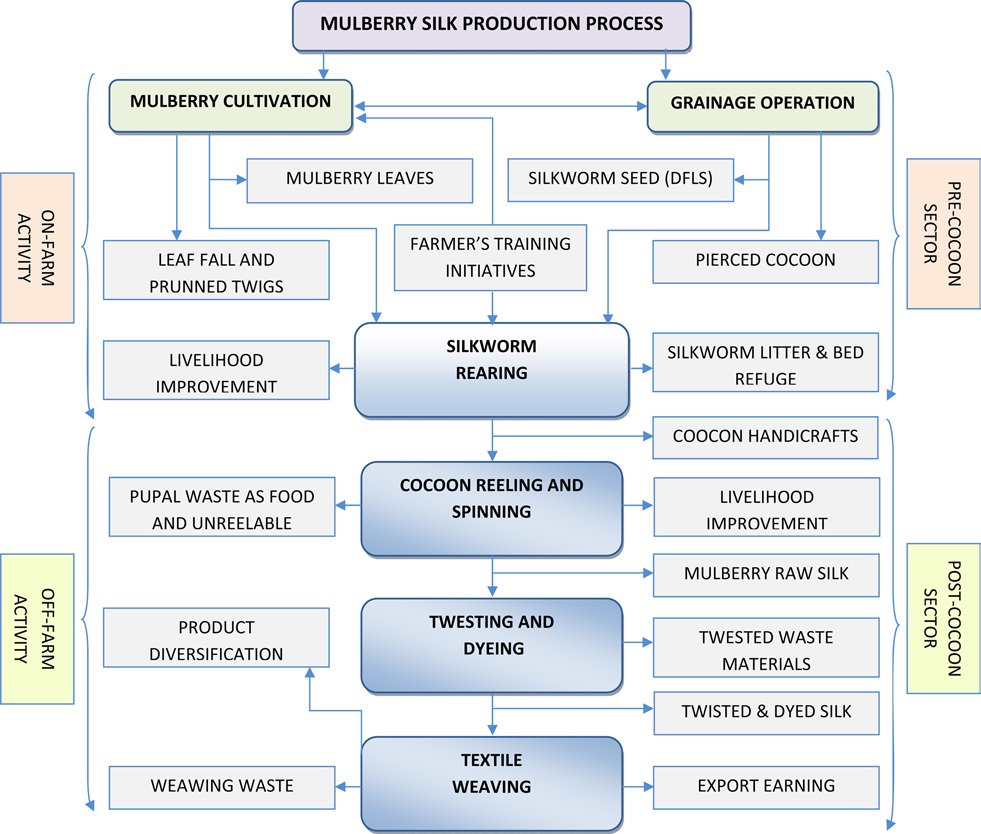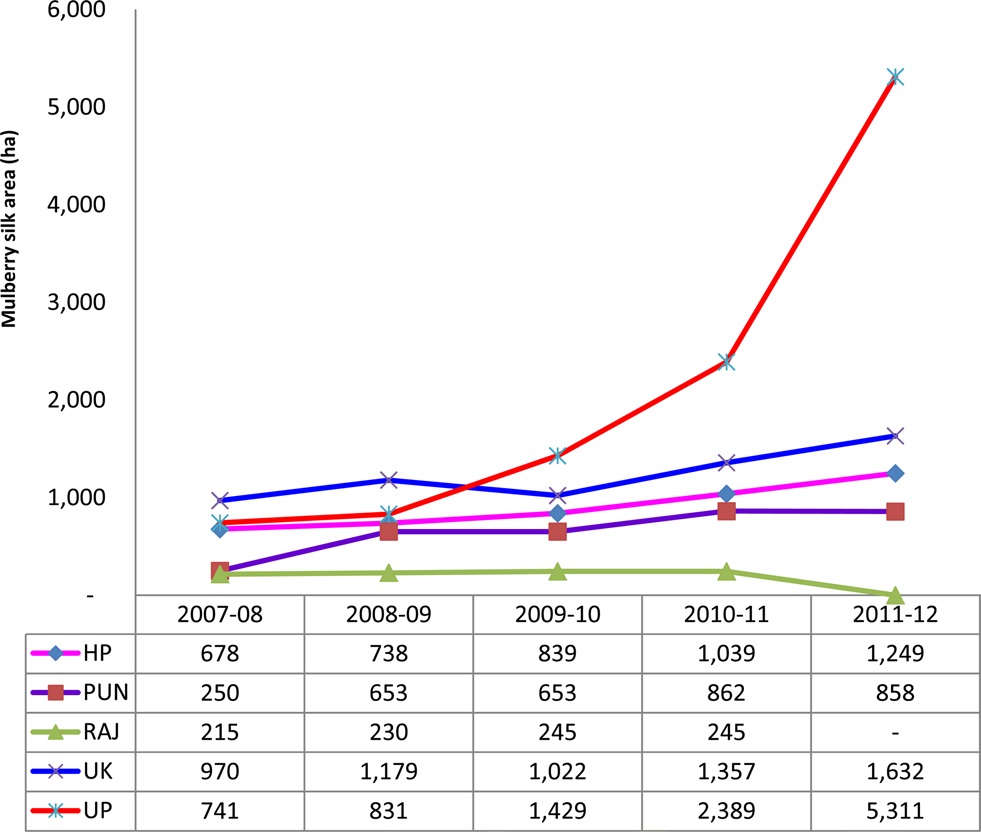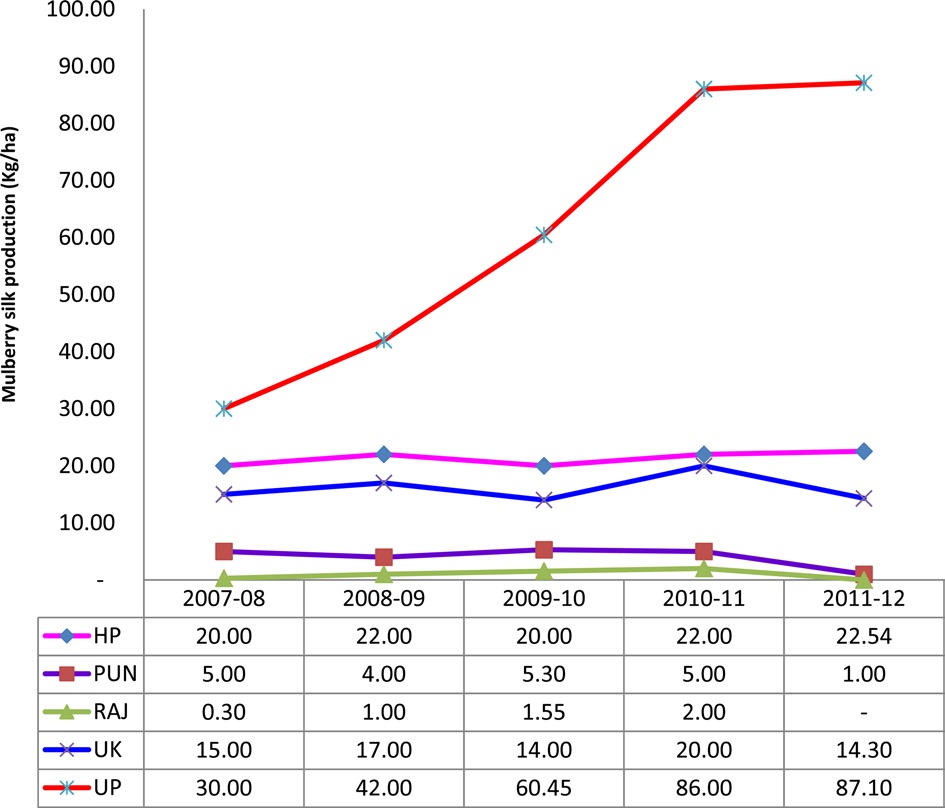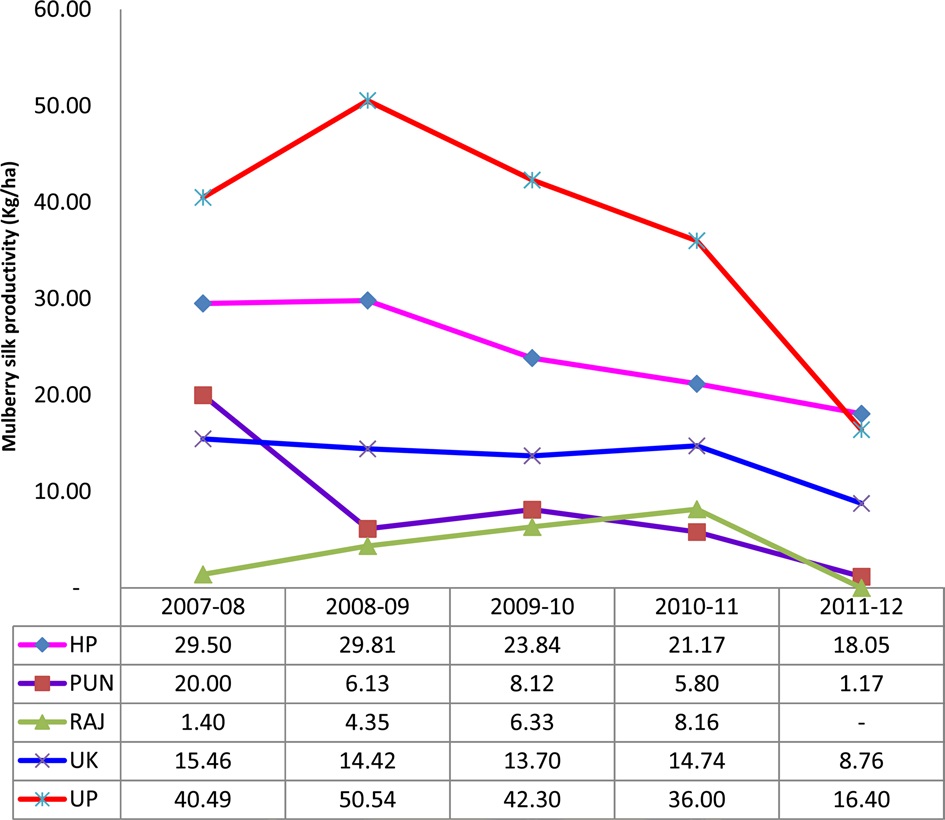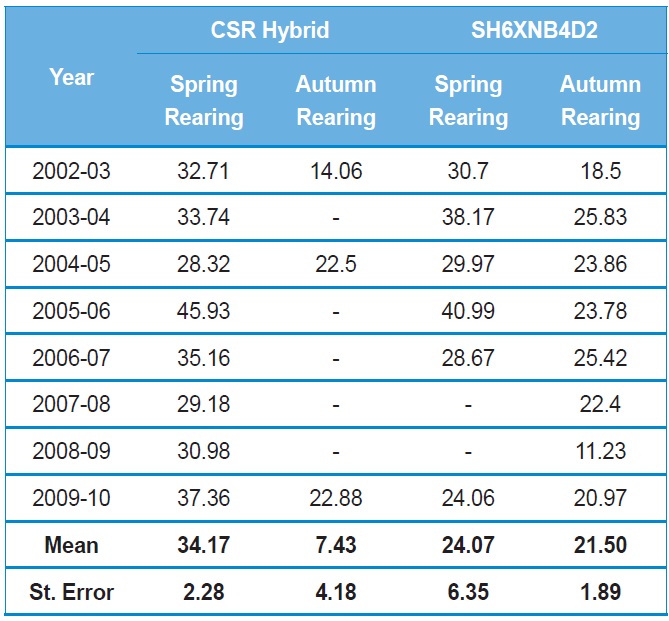



In India, 69% of the population lives in rural area and depends on agriculture for their livelihood. However, according to the National Sample Survey (NSS) published in 2012, the growth rate of employment in agriculture sector has declined from 69% to 55% and 70 million people in rural India are without employment. Further, 40% people in rural area want to leave agriculture, if they get better livelihood option (Gautam and Bhardwaj. 2013), because Indian agriculture have certain constraints like limited cash returns, low per capita availability of cultivable land, monsoon dependency, seasonality effect etc. Given both the on-farm and off-farm employment potential, sericulture industry can nullify the seasonality effect in agriculture.
Sericulture in India is an indispensible part of tradition and as an exclusive craft; it holds a unique distinction in traditional knowledge and societal evolution of poor communities in rural areas. Innovations in sericulture technology have improved silk
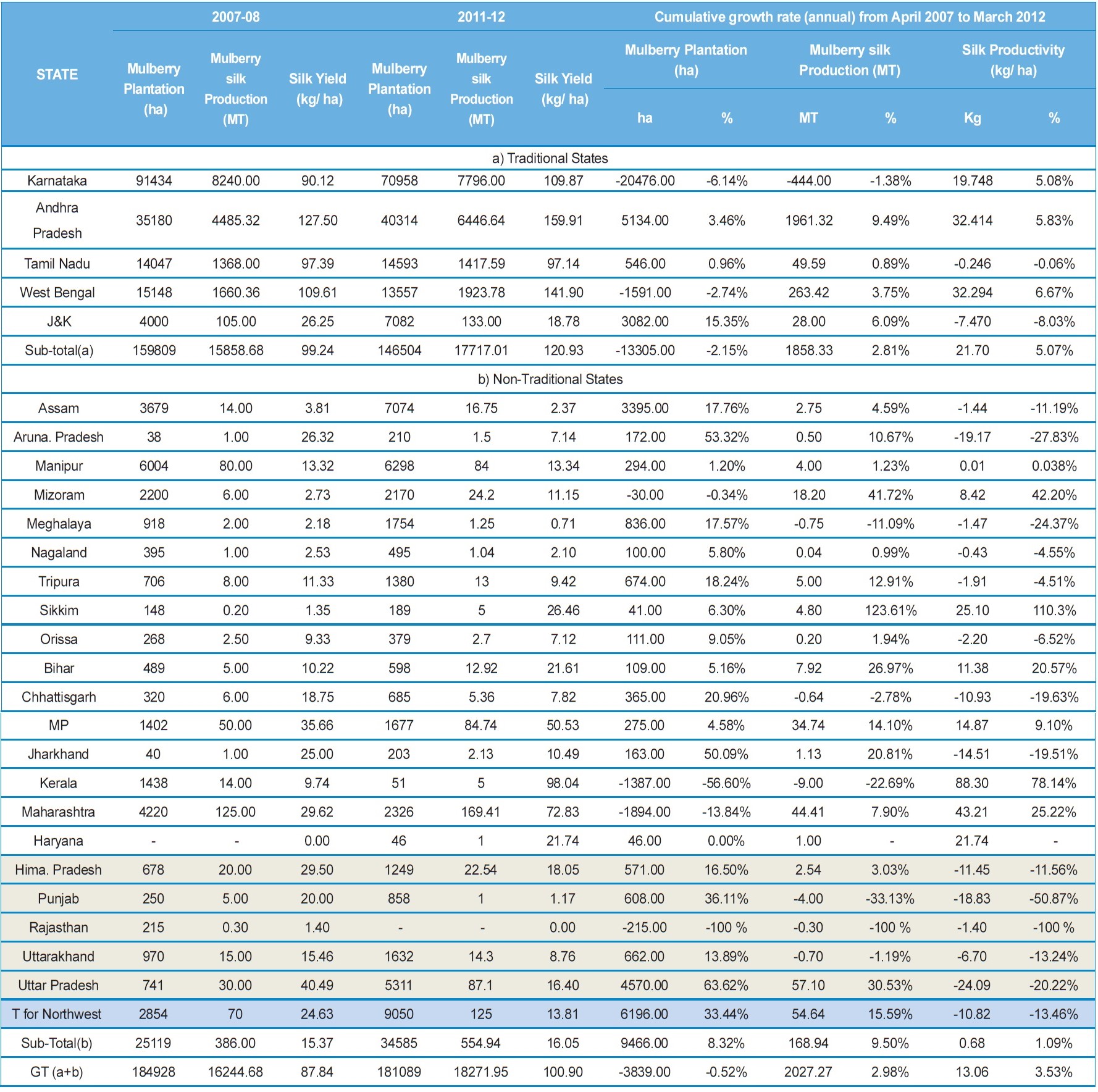
State wise progress of mulberry sericulture in India in 11th plan period (year 2007 to 2012)
productivity at national level, but their impact in northwest India has been quite uneven. Per hectare raw silk productivity in India has increased from 87.84 kg/ha in 2007 to 100.90 kg/ha in 2012, but in northwest non-traditional states, which includes Himachal Pradesh, Punjab, Rajasthan, Uttarakhand and Uttar Pradesh, it has reduced to 13.81 kg/ha in 2012 from 24.63 kg/ha in 2007 (Table 1). As a result, reduced farmer income has decelerated the proliferation process of sericulture industry and has increased the burden of silk import to meet out increasing domestic demand.
Analysis of productivity in sericulture has vast dimension; however, in sericulture yield-gap-analysis, we generally measure the determinants of yield gap. The findings of such research are used in policy formulation to alleviate constraints of low cocoon productivity at national as well as regional level. Conceptually, there are two types of cocoon yield gap in sericulture: Yield gap- 1 and Yield gap-2. Yield gap-1 indicates the gap between potential cocoon yield of a sericulture research station and the cocoon yield of a demonstration plot. Yield gap 1 is mainly attributed to differences in the locality factors (soil, slope, aspect, moisture regime, climatic deviations, etc) and to non-transferable part of technology. However, yield gap-2 deals with the difference between potential cocoon yield of a demonstration plot and the cocoon yield at farmer’s level. Yield gap-2 is very common, and mostly arises when sericulture farmers use inappropriate technology, apply low inputs, and face managerial constraints, besides physical and socio-economic constraints affecting the farming community.
In traditional silk producing states of India, quite a number of studies have been undertaken on trends, profitability, and cocoon yield gap analysis in one form or other (Kumaresan
a) Trends analysis of mulberry sericulture in northwest India; and
b) To identify the constraints of cocoon yield gap-2 and to find out viable measures to reduce it.
>
Background information of Sericulture
Commercial silk producing insects of order Lepidoptera are classified into mulberry and non-mulberry or
On the demand and supply front, India is the second largest producer of silk in the world next to the China (104, 000 MT), but shares only 17.5 % (23,060 MT) of the global raw silk production (131,479 MT). In India, there is a deficit of 5,700 MT raw silk between demand (28,760 MT) and supply (23,060 MT), which is largely imported from China. Projected growth of raw silk production in India is about 4.5% for 2010-2015 and 5.0% for 2015-20; however, demand of silk is expected to grow by 3.5% and 4.0% during the corresponding period (NFP, 2011).
>
Production process of mulberry sericulture in northwest India
In northwest India, fast urbanization due to demographic expansion has reduced agricultural acreage and have forced “mulberry” to exist only on the boundaries of agriculture field (Fig. 1a). The whole process of mulberry sericulture (Fig. 2) is divided in to pre-cocoon and post-cocoon sector. Management of mulberry trees and conducting indoor silkworm rearing to produce silk cocoon is on-farm activity in pre-cocoon sector, whereas reeling, dying and weaving are off-farm activity of post-cocoon sector. During silkworm’s rearing,
The study was conducted in five non-traditional silk producing states of India comprising, Himachal Pradesh, Punjab, Rajasthan, Uttarakhand, and Uttar Pradesh. The climate of Himachal Pradesh and Uttarakhand suits for production of quality bivoltine silk. However, in Uttar Pradesh, Punjab and Rajasthan, both bivoltine and multi-bivoltine breeds are reared. In Himachal Pradesh, sericulture is practiced in the districts of Hamirpur, Bilaspur, Mandi, Kangra, Shimla, Solan, Sirmaur, and Una. In Uttar Pradesh, mulberry sericulture exists in 46 districts with maximum mulberry acreage in Saharanpur (87.0 ha) followed by Kushinagar (50.58 ha) and Bahraich (40.46 ha). There are 39 state sericulture farms with 485.62 ha of mulberry in Uttar Pradesh and four-crop schedule is followed for commercial silkworm rearing (DOS, 2013). In Rajasthan, mulberry sericulture is practiced in Udaipur, Banswara, Sirohi and Kota with integration of Central Silk Board (CSB) and Tribal Area Development Authorities (TADA). In Punjab, sericulture activities have been initiated in Sujanpur, Pathankot, and Gurdaspur with total mulberry area of 608 ha with 475 farmers. Uttarakhand state has congenial climatic conditions for bivoltine mulberry silk, and there are 69 state sericulture farms with 475 farmers.
Data on mulberry area and silk production during 11th plan period (April 2007 to March 2012) was collected from different reports of the Central Silk Board, Ministry of Textiles, Government of India. We used Microsoft Office Excel 2007 to calculate annual linier growth rate (LGR) on three variables of sericulture progress viz., mulberry area, total raw silk production, and per hectare raw silk productivity. Information about moriculture (cultivation of mulberry) practices, silkwormcropping patterns, implementation of improved rearing technology, reared silkworm’s breed, occurrence of silkworm disease and process of cocoon marketing etc. were collected during field visits through one-to-one interactions with the farmers and officials of concerned department of sericulture. Data on state wise silk production, silkworm breeds reared, and their productivity at farmer’s level was collected from concerned department of sericulture in the respective states.
Statistical analysis of the data was carried out with the help of statistical software “STATISTICA” developed by the Stat Soft Inc, 2300 East 14th Street, Tulsa, UK. We employed descriptive statistics and frequency analysis to analyze most of the data. One-way ANOVA was used to test the significance of difference
in means of the variables. The level of significance for the study was fixed at 0.05. Post HOC test was carried out by using Tukey’s HSD test to compare the homogeneous pairs of means.
Mulberry silk in India is produced in twenty-six states that are grouped into traditional and non-traditional states. Data presented at Table 1 indicates that non-traditional states contribute 19.10 % (34,585 ha)
of the total mulberry acreage (181,089 ha), but share only 3.0% (555 MT) of the total mulberry raw silk production (18,272 MT). This disproportion in mulberry area
In
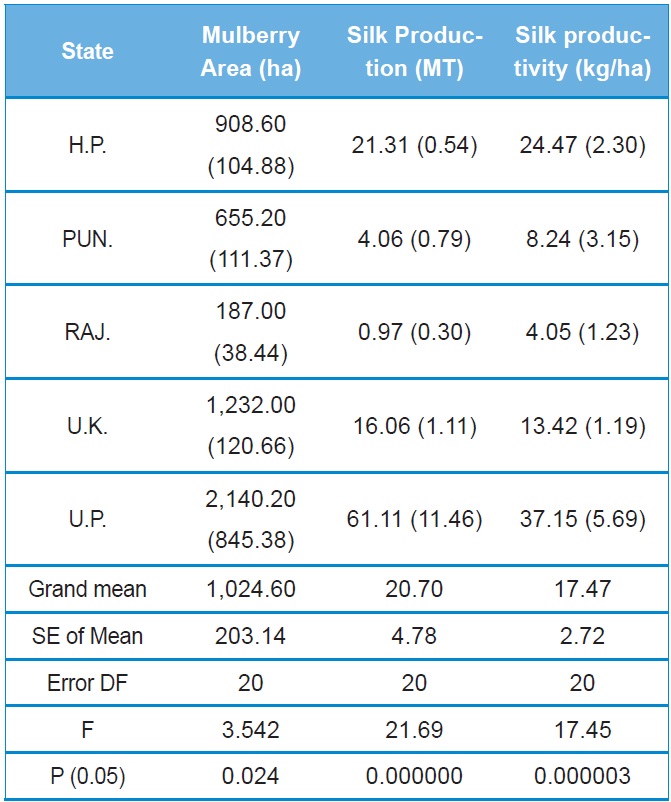
Descriptive statistics and ANOVA on mulberry area, silk production and productivity in northwest India during 11th plan period ( 2007-2012)
but this physical progress in mulberry acreage could not commensurate with improvement in silk production and productivity, rather it declined at annual linear growth rate of -1.19% and -13.24%, respectively. In northwest India, during 11th plan period (2007-2012), there was an addition of 6196 ha (217.09 %) in mulberry acreage at annual linear growth rate of 33.44%; however,
[Table 3.] Tukey HSD test for Homogenous Groups

Tukey HSD test for Homogenous Groups
total silk production could increase only by 54.64 MT (78.57%) at annual linear growth rate of 15.59 % due to 43.93% (10.82 kg/ha) reduction in raw silk productivity at annual linear growth rate of -13.46%. Now, average raw silk productivity of northwest India remains at 13.81 kg/ha, which is lower by 452.93 % (76.36 kg) in comparison to the national average of 100.90 kg/ha.
Further, Descriptive statistics on progress of sericulture in northwest India indicated higher consistency in term of silk productivity than mulberry acreage and silk production (Table 2). Null hypothesis (H0) for no difference in all the variables was rejected by ANOVA. Tukey’s HSD test presented at Table 3 indicated that average mulberry acreage of Uttar Pradesh (2140.20 ha) and Rajasthan (187 ha) differ significantly. Secondly, raw silk production of Uttar Pradesh (61.11 MT) differed significantly with all other states of northwest India, however, other pairs of means on raw silk production were found homogenous. Third, average raw silk productivity of Uttar Pradesh (37.15 kg/ha) differed significantly with the productivity of Uttarakhand (13.42 kg/ka), Punjab (8.24) and Rajasthan (4.05); however silk productivity of Uttarakhand, Punjab and Rajasthan was found homogeneous. Similarly, there was no any significant difference in the mean raw silk productivity of Himachal Pradesh and Uttarakhand and between Uttar Pradesh and Himachal Pradesh.
Agricultural land holdings in northwest India are generally used to grow cereals and vegetables for domestic consumption and marketing. Sericulture farmers in northwest India normally
[Table 4.] Seasonal variation in cocoon productivity of Uttarakhand
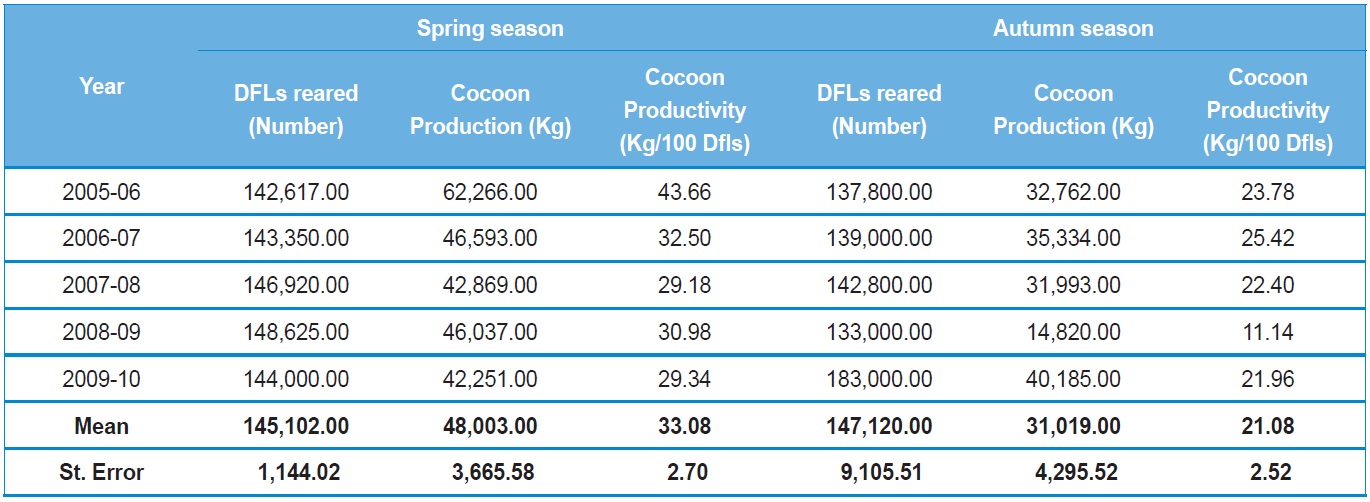
Seasonal variation in cocoon productivity of Uttarakhand
use bunds of their agriculture field to raise mulberry tree (Fig. 1). Mulberry trees grown on the field boundaries are not governed by any manuring or pruning schedule, which reduces optimum leaves production efficiency that affects cocoon productivity.
In northwest India, there exist only two-silkworm crop schedule due to climatic restriction except to Uttar Pradesh, where four-crop schedule is being followed. Stabilized spring crop is the main crop with higher productivity and autumn crop is the secondary crop with low productivity. For example, in Uttarakhand, cocoon productivity of spring crop (33.08 Kg/100 disease free layings) is 60.34% higher than the productivity of autumn (21.08 kg/100 disease free layings), but average demand of Dfls (disease free layings of silkworm) in both the seasons is almost same (Table 4). Interestingly, availability of mulberry leaves is double in autumn crop than the spring rearing. Therefore, by increasing the quantum of rearing in spring season, cocoon production and productivity, both can be increased; however, to achieve this, availability of mulberry leaves for spring rearing is to be increased. The existing pruning schedule may be adjusted according to the changing climate, besides application of recommended manure and fertilizers by the farmers to increase the availability of mulberry leaves for enhanced Dfls intake in spring rearing.
The available bivoltine breeds for northwest India are comparatively more suitable for spring rearing, but in summer, they succumb to different diseases. It is observed that ruling hybrid SH6 x NB4D2 is now showing some problem of disease susceptibility in the final stage worms on 5th day onwards. On the other hand, new developed hybrid Dun6 x Dun22 is not being taken up at farmer’s level in larger quantity, beside its proved potential. Further, CSR breeds are being taken up in spring as
[Table 5.] Average productivity of major silkworm hybrids in Uttarakhand (Kg cocoons /100 Dfls)

Average productivity of major silkworm hybrids in Uttarakhand (Kg cocoons /100 Dfls)
well as in autumn; however, it is known that CSR breeds require good rearing conditions and quality leaves for expression on their full potential. In a case study, impact of promising silkworm breeds on cocoon productivity in Uttarakhand is analyzed (Table 5) and it is found that in spring crop, both CSR breeds and SH6 X NB4D2 have performed at par with an average productivity of 34.17 Kg/ 100 DFLs and 32.09 Kg, respectively; however, in autumn crop the performance of SH6 x NB4D2 is quite better then the CSR hybrids, and < 90% of total cocoons production is contributed by SH6 x NB4D2. From these observations, it can be construed that in autumn crop, ruling hybrid SH6 x NB4D2 can be preferred over CSR breeds. Furthermore, autumn specific hybrids that can sustain high pathogen load may be evolved through directional breeding programmes and sturdy silkworm breeds that could tolerate high temperature and low humidity could be developed to increase the remunerability of sericulture in northwest India by adding one more crop in May-June. Workable technology to harvest and preserve the quality mulberry leaves in summer season will also be required.
Success and profitability of silkworm rearing primarily rely on quality of seed being the basic input, and the quality of mulberry leaves. However, most vitally, the disease component occupies a prime importance, because in autumn crop, the incidence of silkworm diseases (Fig. 1c) is as high as 35-100% in northwest India that reduces the viability of sericulture. As a ground reality, the silkworm rearing practices in the rural areas are not full proof for prevention of diseases, as silkworms are reared in the rearing cum dwelling houses and most of them are unhygienic, badly ventilated, dark, and damp helping in pathogen survival. It is also observed that many of the farmers do not follow disinfection procedures effectively and
Development of cost effective technologies suitable to the local environment and socioeconomic conditions of the farmers is prerequisite for mulberry sericulture. It is found that most of the farmers in northwest India are not self-sufficient with rearing appliances and space to carry out silkworm rearing as per the recommended packages. Farmers follow floor rearing with crowded worm’s population in poor hygiene (Fig. 1d) that leads to disease outbreak. Crowded worm population per unit area dissolves many of the impacts of improved rearing technology and extension efforts.
In northwest India, feasibility of shoot rearing from tree mode of plantation should be explored out, which will not only solve the space constraints by spreading silkworm population in different tiers on mulberry twigs, but will also reduce loss of mulberry leaves and negative impact of missing feedings. Further, mortality during spinning stage due to improper mounting is also a cause for low cocoon production in northwest India. Improper mounting leads to 13?18% cocoons loss. Rotary mountages may be introduced in the field to reduce the cocooning losses and farmers should be properly trained for mounting and rotation of the mountages.
Participatory approach for technology transfer has shown promising results in agriculture sector, which can also be tried in sericulture sector. Lead farmer concept, training of at least five unemployed youth from every sericulture cluster, linkage of Krishi Vigyan Kendras (KVKs) of Indian Council of Agricultural Research (ICAR) with sericulture cluster, establishment of farmer field school are some of the other viable options for smooth transfer the improved sericulture technologies to the farmers for reducing existing yield gap. Marketing system of silk cocoon is not adequately systematic in northwest India and farmers are not getting competitive pricing of cocoon like traditional state. Several state departments in northwest India have evolved auction method of cocoon marketing, but many farmers have questioned about business transparency.
In northwest India, the state owned government sericulture farms heavily support farmer’s silkworm rearing by providing mulberry leaves. However, some people argue that these farms are not maintained to their installed capacity. Further, mulberry is a heavy feeder that replace huge nutrients base from soil, and application of soil nutrients are not properly monitored some tine. Soil profile of sericulture areas and state owned sericulture farms needs to be calibrated to apply test-based nutrients to improve soil health. Proper maintenance of the government sericulture farms is the basic requisite to turn out alternative sericulture of northwest India into a substantive sericulture.
According to Forest (Conservation) Act 1980, plantation of mulberry in forest area for silkworm rearing is not a forestry activity. Ministry of Environment and Forest may be perused to include plantation of mulberry tree in various agroforestry schemes under Forests (Conservation) Act, 1980 in northwest India. This will improve the livelihood delivery of forest to the poor people in forested area. And for this purpose, existing 106,479 Joint Forest Management Committees (JFMCs) in 28 states that are managing 22.02 m ha forest (Planning Commission, 2011) can be integrated with respective department of sericulture to realize benefits of forest-based sericulture under collaborative forest management and concomitantly foster its impact on incentive linked forest management initiatives.
Constraints in taking more than two crops in a year, shortage of quality mulberry leaves, revalidation of pruning and brushing schedule, development of thermo tolerant silkworm breeds, improvement in rearing technologies, disinfection and hygiene, disease management aspect, transfer of improved sericulture technology, evolving market linkages, policy decision to include mulberry in Forest (Conservation) Act 1980, etc are some of the vital issues, which requires proper attention from the sericulture research and development sector to reduce yield gap at farmer’s level and to make sericulture a profitable business in northwest India. Sericulture will sustain automatically if productivity per unit area of land is increased, and this can only happen, if existing constraints are removed are at least lowered down.

